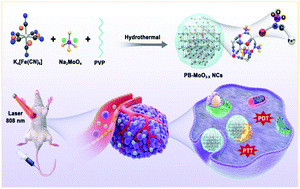Plasmonic MoO3−x nanoparticles incorporated in Prussian blue frameworks exhibit highly efficient dual photothermal/photodynamic therapy†
Abstract
Development of near infrared (NIR) light-responsive nanomaterials for high performance multimodal phototherapy within a single nanoplatform is still challenging in technology and biomedicine. Herein, a new phototherapeutic nanoagent based on FDA-approved Prussian blue (PB) functionalized oxygen-deficient molybdenum oxide nanoparticles (MoO3−x NPs) is strategically designed and synthesized by a facile one-pot size/morphology-controlled process. The as-prepared PB-MoO3−x nanocomposites (NCs) with a uniform particle size of ∼90 nm and high water dispersibility exhibited strong optical absorption in the first biological window, which is induced by plasmon resonance in an oxygen-deficient MoO3−x semiconductor. More importantly, PB-MoO3−x NCs not only exhibited a high photothermal conversion efficiency of ∼63.7% and photostability but also offered a further approach for the generation of reactive oxygen species (ROS) upon singular NIR light irradiation which significantly improved the therapeutic efficiency of the PB agent. Furthermore, PB-MoO3−x NCs showed a negligible cytotoxic effect in the dark, but an excellent therapeutic effect toward two triple-negative breast cancer (TNBC) cell lines at a low concentration (20 μg mL−1) of NCs and a moderate NIR laser power density. Additionally, efficient tumor ablation and metastasis inhibition in a 4T1 TNBC mouse tumor model can also be realized by synergistic photothermal/photodynamic therapy (PTT/PDT) under a single continuous NIR wave laser. Taken together, this study paved the way for the use of a single nanosystem for multifunctional therapy.



 Please wait while we load your content...
Please wait while we load your content...